Monthly Updates on Recent Books in the History of Christianity
To raise awareness of recent books in the history of Christianity, the editorial staff of Church History: Studies in Christianity and Culture highlights each month a list of 10-15 books in diverse periods and geographical regions that we hope will be of interest to our members. We include here below the eleventh monthly list, chosen by our staff, with excerpts from the publishers’ blurbs.

Philip Wood, The Imam of the Christians: The World of Dionysius of Tel-Mahre, c. 750-850. 2021
The Imam of the Christians examines how Christian leaders adopted and adapted the political practices and ideas of their Muslim rulers between 750 and 850 in the Abbasid caliphate in the Jazira (modern eastern Turkey and northern Syria). Focusing on the writings of Dionysius of Tel-Mahre, the patriarch of the Jacobite church, Philip Wood describes how this encounter produced an Islamicate Christianity that differed from the Christianities of Byzantium and western Europe in far more than just theology. In doing so, Wood opens a new window on the world of early Islam and Muslims’ interactions with other religious communities.
Wood shows how Dionysius and other Christian clerics, by forging close ties with Muslim elites, were able to command greater power over their coreligionists, such as the right to issue canons regulating the lives of lay people, gather tithes, and use state troops to arrest opponents. In his writings, Dionysius advertises his ease in the courts of ʿAbd Allah ibn Tahir in Raqqa and the caliph al-Ma’mun in Baghdad, presenting himself as an effective advocate for the interests of his fellow Christians because of his knowledge of Arabic and his ability to redeploy Islamic ideas to his own advantage. Strikingly, Dionysius even claims that, like al-Ma’mun, he is an imam since he leads his people in prayer and rules them by popular consent.
A wide-ranging examination of Middle Eastern Christian life during a critical period in the development of Islam, The Imam of the Christians is also a case study of the surprising workings of cultural and religious adaptation.
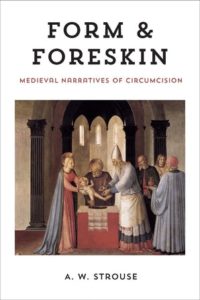
A.W. Strouse, Form and Foreskin: Medieval Narratives of Circumcision. 2021
Why did Saint Augustine ask God to “circumcise [his] lips”? Why does Sir Gawain cut off the Green Knight’s head on the Feast of the Circumcision? Is Chaucer’s Wife of Bath actually—as an early glossator figures her—a foreskin? And why did Ezra Pound claim that he had incubated The Waste Land inside of his uncut member? In this little book, A. W. Strouse excavates a poetics of the foreskin, uncovering how Patristic theologies of circumcision came to structure medieval European literary aesthetics. Following the writings of Saint Paul, “circumcision” and “uncircumcision” become key terms for theorizing language—especially the dichotomies between the mere text and its extended exegesis, between brevity and longwindedness, between wisdom and folly. Form and Foreskin looks to three works: a peculiar story by Saint Augustine about a boy with the long foreskin; Sir Gawain and the Green Knight; and Chaucer’s Wife of Bath’s Tale. By examining literary scenes of cutting and stretching, Strouse exposes how Patristic treatments of circumcision queerly govern medieval poetics.
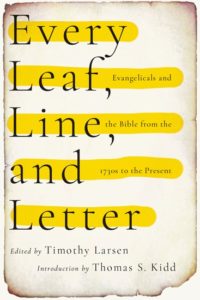
Timothy Larsen, ed. Every Leaf, Line, and Letter: Evangelicals and the Bible from the 1730s to the Present. 2021
"I was filled with a pining desire to see Christ's own words in the Bible. . . . I got along to the window where my Bible was and I opened it and . . . every leaf, line, and letter smiled in my face." —The Spiritual Travels of Nathan Cole, 1765
From its earliest days, Christians in the movement known as evangelicalism have had "a particular regard for the Bible," to borrow a phrase from David Bebbington, the historian who framed its most influential definition. But this "biblicism" has taken many different forms from the 1730s to the 2020s. How has the eternal Word of God been received across various races, age groups, genders, nations, and eras?
This collection of historical studies focuses on evangelicals' defining uses—and abuses—of Scripture, from Great Britain to the Global South, from the high pulpit to the Sunday School classroom, from private devotions to public causes.

Sergey Minov and Flavia Ruani, eds. Syriac Hagiography: Texts and Beyond. 2021
Chapters gathered in Syriac Hagiography: Texts and Beyondexplore a wide range of Syriac hagiographical works, while following two complementary methodological approaches, i.e. literary and cultic, or formal and functional. Grouped into three main sections, these contributions reflect three interrelated ways in which we can read Syriac hagiography and further grasp its characteristics: “Texts as Literature” seeks to unfold the mechanisms of their literary composition; “Saints Textualized” offers a different perspective on the role played by hagiographical texts in the invention and/or maintenance of the cult of a particular saint or group of saints; “Beyond the Texts” presents cases in which the historical reality behind the nexus of hagiographical texts and veneration of saints can be observed in greater details.
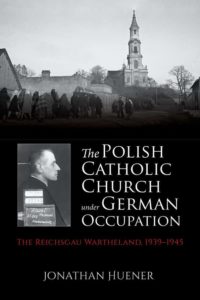
Jonathan Huener, The Polish Catholic Church under German Occupation: The Reichsgau Wartheland, 1939-1945. 2021
When Nazi Germany invaded Poland in 1939, it aimed to destroy Polish national consciousness. As a symbol of Polish national identity and the religious faith of approximately two-thirds of Poland's population, the Roman Catholic Church was an obvious target of the Nazi regime's policies of ethnic, racial, and cultural Germanization.
Jonathan Huener reveals in The Polish Catholic Church under German Occupation that the persecution of the church was most severe in the Reichsgau Wartheland, a region of Poland annexed to Nazi Germany. Here Catholics witnessed the execution of priests, the incarceration of hundreds of clergymen and nuns in prisons and concentration camps, the closure of churches, the destruction and confiscation of church property, and countless restrictions on public expression of the Catholic faith. Huener also illustrates how some among the Nazi elite viewed this area as a testing ground for anti-church policies to be launched in the Reich after the successful completion of the war. Based on largely untapped sources from state and church archives, punctuated by vivid archival photographs, and marked by nuance and balance, The Polish Catholic Church under German Occupation exposes both the brutalities and the limitations of Nazi church policy.
The first English-language investigation of German policy toward the Catholic Church in occupied Poland, this compelling story also offers insight into the varied ways in which Catholics—from Pope Pius XII, to members of the Polish episcopate, to the Polish laity at the parish level—responded to the Nazi regime's repressive measures.

John P. Hawkins, ed. Religious Transformation in Maya Guatemala: Cultural Collapse and Christian Pentecostal Revitalization. 2021
University of New Mexico Press
Mayas, and indeed all Guatemalans, are currently experiencing the collapse of their way of life. This collapse is disrupting ideologies, symbols, life practices, and social structures that have undergirded their society for almost five hundred years, and it is causing rapid and massive religious transformation among the K’iche’ Maya living in highland western Guatemala. Many Mayas are converting to Christian Pentecostal faiths in which adherents and leaders become bodily agitated during worship.
Drawing on over fifty years of research and data collected by field-school students, Hawkins argues that two factors—cultural collapse and systematic social and economic exclusion—explain the recent religious transformation of Maya Guatemala and the style and emotional intensity through which that transformation is expressed. Guatemala serves as a window on religious change around the world, and Hawkins examines the rapid pentecostalization of Christianity not only within Guatemala but also throughout the global South. The “pentecostal wail,” as he describes it, is ultimately an acknowledgment of the angst and insecurity of contemporary Maya.
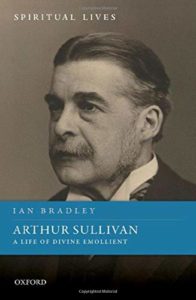
Ian Bradley, Arthur Sullivan: A Life of Divine Emollient. 2021
This book charts the life of Arthur Sullivan--the best loved and most widely performed British composer in history. While he is best known for his comic opera collaborations with W. S. Gilbert, it was his substantial corpus of sacred music which meant most to him and for which he wanted to be remembered. His upbringing and training in church music, and his own religious beliefs, substantially affected both his compositions for the theatre and his more serious work, which included oratorios, cantatas, sacred ballads, liturgical pieces, and hymns.
Focusing on the spiritual aspects of Sullivan's life--which included several years as a church organist, involvement in Freemasonry, and an undying attachment to Anglican church music--Ian Bradley uses hitherto undiscovered letters, diary entries, and other sources to reveal the important influences on his faith and his work. No saint and certainly no ascetic, he was a lover of life and enjoyed its pleasures to the full. At the same time, he had a rare spiritual sensitivity, a sincere Christian faith, and a unique ability to uplift through both his character and his music that can best be described as a quality of divine emollient.
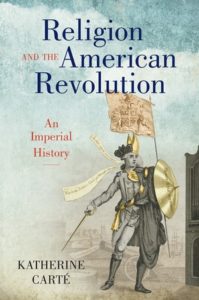
Katherine Carté, Religion and the American Revolution: An Imperial History. 2021
University of North Carolina Press
For most of the eighteenth century, British protestantism was driven neither by the primacy of denominations nor by fundamental discord between them. Instead, it thrived as part of a complex transatlantic system that bound religious institutions to imperial politics. As Katherine Carte argues, British imperial protestantism proved remarkably effective in advancing both the interests of empire and the cause of religion until the war for American independence disrupted it. That Revolution forced a reassessment of the role of religion in public life on both sides of the Atlantic. Religious communities struggled to reorganize within and across new national borders. Religious leaders recalibrated their relationships to government. If these shifts were more pronounced in the United States than in Britain, the loss of a shared system nonetheless mattered to both nations.
Sweeping and explicitly transatlantic, Religion and the American Revolution demonstrates that if religion helped set the terms through which Anglo-Americans encountered the imperial crisis and the violence of war, it likewise set the terms through which both nations could imagine the possibilities of a new world.
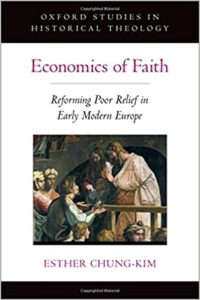
Esther Chung-Kim, Economics of Faith: Reforming Poverty in Early Modern Europe. 2021
Economics of Faith examines the role of religious leaders in the development of poor relief institutions in early modern Europe. As preachers, policy makers, advocates, and community leaders, these reformers offered a new interpretation of salvation and good works that provided the religious foundation for poor relief reform. Although poverty was once associated with the religious image of piety, reformers no longer saw it as a spiritual virtue. Rather they considered social welfare reform to be an integral part of religious reform and worked to modify existing poor relief institutions or to set up new ones.
Population growth, economic crises, and migration in early modern Europe caused poverty and begging to be an ever-increasing concern, and religious leaders encouraged the development and expansion of poor relief institutions. This new cadre of reformers served as catalysts, organizers, stabilizers, and consolidators of strategies to alleviate poverty, the most glaring social problem of early modern society. Although different roles emerged from varying relationships and negotiations with local political authorities and city councils, reform-minded ministers and lay leaders shaped a variety of institutions to address the problem of poverty and to promote social and communal responsibility. As religious options multiplied within Christianity, one's understanding of community determined the boundaries, albeit contested and sometimes fluid, of responsible poor relief. This goal of communal care would be especially relevant for religious refugees who as foreigners and strangers became responsible for caring for their own group.

Michael Wilkinson, Connie Au, Jörg Haustein, and Todd M. Johnson, eds. Brill’s Encyclopedia of Global Pentecostalism. 2021
The rise of Pentecostalism is one of the most important changes in Christianity in the past century. Growing rapidly, it has expanded throughout the world.
How many Pentecostals are there in the world? How did Pentecostalism grow so fast? What do Pentecostals believe? What role did revivals play like the Azusa Street Revival in the USA or the Mukti Mission Revival in India? What do Pentecostals experience when they speak in tongues, pray for healing, and seek prosperity?
Brill's Encyclopedia of Global Pentecostalism answers such questions, drawing upon disciplines such as anthropology, biblical studies, economics, gender studies, history, theology, and other areas of related interest.

Esther Sahle, Quakers in the British Atlantic World, c.1660-1800. 2021
The book studies the two largest Quaker communities in the early modern British Atlantic World, London and Philadelphia. It looks at the origins of the Society of Friends in mid seventeenth century England and follows its development into a well organised sect with a sophisticated organisational structure spreading across the Atlantic world. The book zooms in on the Quaker communities in these two important port cities, as well as their relationships with non-Quaker inhabitants. It scrutinizes the role of Quaker merchants and the business ethics they followed.
Drawing on many unpublished sources, the study is able to portray a mid-eighteenth-century crisis for the Quaker communities when sanctions for offences against the prevailing disciplines in business (fraud, debt, bankruptcy) and marriage increased dramatically. And yet these Quaker communities got likewise caught up in wider political developments across the British Empire. In the course of a series of conflicts affecting colonial Pennsylvania in the mid eighteenth century, the Society of Friends suffered grave reputational damage. The public in England and Pennsylvania began to perceive Quakers as a sect that put its own agenda and interest over the welfare of the colonial population and the Empire. In turn, these developments led to a "Quaker reformation" and Quaker identity became guided by new principles: honesty in business and religious marital endogamy. The book will be of interest to scholars and students of economic and Atlantic history, as well as Eighteenth-Century studies and religious history.
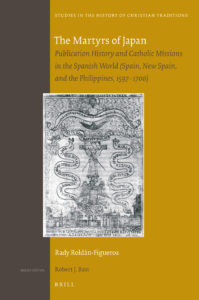
Rady Roldán-Figueroa, The Martyrs of Japan: Publication History and Catholic Missions in the Spanish World (Spain, New Spain, and the Philippines, 1597–1700). 2021
In The Martyrs of Japan, Rady Roldán-Figueroa examines the role that Catholic missionary orders played in the dissemination of accounts of Christian martyrdom in Japan. The work combines several historiographical approaches, including publication history, history of missions, and “new” institutional history. The author offers an overarching portrayal of the writing, printing, and circulation of books of ‘Japano-martyrology.’
The book is organized into two parts. The first part, “Spirituality of Writing, Publication History, and Japano-martyrology,” addresses topics ranging from the historical background of Christianity in Japan to the publishers of Japano-martyrology. The second part, “Jesuits, Discalced Franciscans, and the Production of Japano-martyrology in the Early Modern Spanish World,” features closer analysis of selected works of Japano-martyrology by Jesuit and Discalced Franciscan writers.
Finally, for staying up-to-date on the latest titles in all fields, we recommend regularly perusing New Books Network and its "New Books in Christian Studies” page. These pages are updated regularly.
